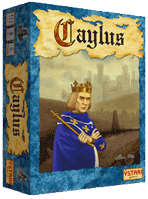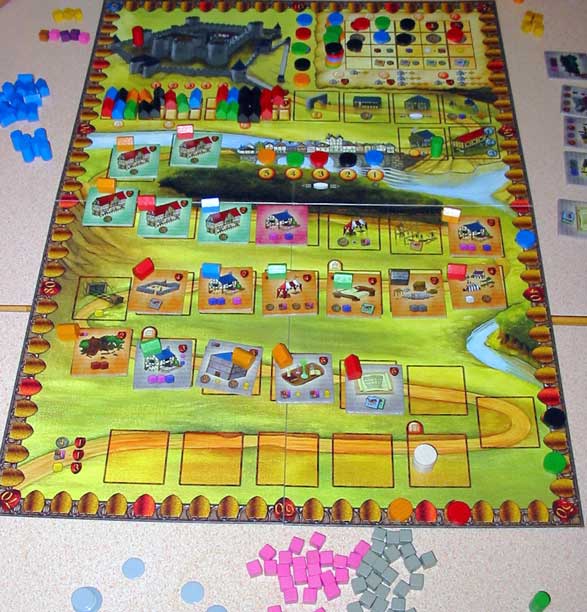Pevans
Caylusreviewed by Pevans |
 Back in 2004, one of the games causing a stir at Spiel was Ys from French publisher Ystari Games. I was rather taken with this game (designed by Cyril Demaegd), despite my usual inability to out-guess my opponents at secret bidding games. Last year Ystari did it again with Caylus, which created even more of a buzz. I got to try it late on in the show and was impressed. Iíve played it a few more times since them and Iím even more impressed.
Back in 2004, one of the games causing a stir at Spiel was Ys from French publisher Ystari Games. I was rather taken with this game (designed by Cyril Demaegd), despite my usual inability to out-guess my opponents at secret bidding games. Last year Ystari did it again with Caylus, which created even more of a buzz. I got to try it late on in the show and was impressed. Iíve played it a few more times since them and Iím even more impressed.
Letís start with the brightly illustrated board. This shows a zigzag road running from the castle at one end. Along the road are the first buildings of a growing town: itís the playersí job to extend the town and complete the castle. Each building provides some service for the player whose worker is there. This is the heart of the game: identifying what you need each turn and getting your workers into the right buildings ahead of your opponents. It is also the challenge, as there are so many things you need to do and you can guarantee that youíll miss out on some of them as other players get there first.
Iíve mentioned workers, so let me explain that each player gets six of these cylindrical pawns (in their chosen colour, natch). Players also have wooden house-shaped pieces to mark ownership of buildings and elements of the castle. Plus a set of marker discs to show turn order and other things. There are lots of cubes for raw materials: wood (brown), stone (grey), food (pink), cloth (purple) and gold (yellow). Plenty of plastic coins for money. A couple of special, white pawns (Bailiff and Provost) control the expansion of the town. And there are the chunky, square tiles that represent the buildings.
The first few buildings are printed on the board and are standard for every game. They do things like changing player order and providing extra cash Ė as shown by the icons on each building. They cannot be re-developed (by playing another building over them), so they remain through the game. The next section is spaces for the half dozen neutral building tiles (with a pink background). These are the same in every game, though their order varies. There are a couple more pre-printed buildings and then the vacant spaces Ė for players to build on Ė begin. The neutral buildings provide raw materials (of different types and combinations) and, crucially, the opportunity to build wooden buildings.
The wooden buildings (with a brown background) give more options Ė like swapping, selling or buying cubes Ė and one of them allows stone buildings to be built. Stone (grey) buildings are more powerful Ė like the bank, which generates gold. Then there are the green, residential buildings, which are built in place of other buildings and generate some victory points immediately and extra income each turn. These, in turn, can be re-developed into prestige buildings (blue tiles), which generate victory points and the very useful royal favours (more about these later).
If youíre with me so far, you can see how important it is to get your workers into the right buildings. Say you want to get the Mason into play. This is the wooden building that allows players to build stone buildings. It is quite an important building (though in the first game I played, we didnít realise that). You need to get a worker onto the carpenter building to have the opportunity to build. You also need to have the raw materials for the tile you want to build (each tile shows whatís needed to build it). This means placing more workers to get these cubes or having them left over from the previous turn. And then you need to get your chance to build before anyone else can take the Mason tile Ė timing is important in this game.
Speaking of timing, Iíd better walk you through the sequence of a turn, so that you can see just what happens when. Each turn starts with everybody getting a couple of coins. (Interestingly, there was some confusion about this and the game has been played with players only getting one cash each turn. This makes a big difference: money is much tighter and players face a big challenge to manage their cash flow.) Then players put their workers on the board. The first player places a worker in an empty building (or the castle) and pays the cost Ė 1 coin to start with. The second player does the same. Then the third and so on until someone passes.
The first player to pass gains a coin. They also increase the cost of placing a worker for the remaining players: itís now two coins. This is a very clever mechanism as it gives passing a positive value, rather than just being what you do when youíve run out of things to do. When a second player passes, the cost goes up to three coins per worker and so on. So, once one personís passed, the others tend to pass soon after as the cost quickly becomes prohibitive. Except that one building keeps the cost down to 1 Ė for the player who took control of it the turn before Ė and the cost of putting a worker into a building you own is always 1. This sums up the game quite neatly: a clever tactical option that makes other tactical opportunities available.

Once everybodyís passed, itís time to activate the buildings, moving along the road. This means that the player who has a worker on the building gets the fruits of whatever the building does. After the first few buildings, the board shows a bridge across the river below the castle. At this point, players get the opportunity to move the Provost pawn, starting with whoever passed first. Moving the Provost costs money, so why do it? Because buildings that are after the Provost on the road do nothing this turn Ė wasting any worker placed on them. Again, this provides some tactical options for the players, depending on just where their workers are and how much cash they have. Once thatís been dealt with, the remaining buildings take effect, in sequence, until the Provost is reached.
This brings us to the castle Ė though itís actually at the head of the road. Every player whoís placed a worker in the castle has the opportunity to build a bit more of it. For each set of three different cubes (thereís a penalty if they have none), they add one of their houses to the current section of the castle. They score some victory points. In addition, the player who adds the most houses in the turn gains a royal favour. Whatís more, as each section of the castle is declared complete, players who havenít put enough houses in lose victory points. Those whoíve put in lots of houses get extra favours.
So Iíd better explain what favours are all about. Each time a player gains a royal favour, they move their marker disc along one of the four tracks on the board. Depending on the track, the player gains extra victory points, extra cash, extra raw materials or an extra building. Initially, the reward from a favour isnít that good: 1 victory point, for example. But the further along the track, the bigger the reward. The 5 points at the end of the victory point track are well worth having. In the first game I played, my opponents didnít bother with favours. Until they saw how well I was doing from them! And a good way of getting favours is by adding to the castle.
At the end of the turn, the Bailiff (that other neutral pawn) moves forward. It moves one space if the Provost pawn is behind it and two if the Provost is ahead. As players have the opportunity to move the Provost, they can thus influence the length of the game. Youíll often see the player whoís ahead forcing the Bailiff forward to reduce other playersí opportunities to catch them. The Bailiff also triggers the scoring for completing sections of the castle when it reaches specific points on the road.
The game ends when the third section of the castle has been scored. Players get a few more points for any resources they still have. This provides another tactic: collecting gold. Each gold cube is worth three points at the end of the game, so a couple of these are significant. Apart from being produced by some of the buildings, gold is available from the gold mine space printed on the board. Players need to keep an eye on whoís using these: letting someone stockpile gold is bad news.
As you can see from the length of my description, this is a complex game. It is also a very tactical game. What you can do depends on the sequence of the buildings on the board, the order of play, how much cash you have and what other players do. Players have to remain flexible so that they can take advantage of whatís available on the board Ėin my experience you definitely need plans B and C each turn. Doing the things other players arenít doing will usually give you an edge, but what this is will change from turn to turn.
I think this is a brilliant game. The richness of the tactics means you are never stuck for something to do. But your limited resources mean you have to decide what you can and canít do. Thereís always the opportunity to find combinations of effects that others have overlooked. And, after five months, Iím still finding new things in the game. Iím sure the options are finite, but Iíve not reached the end of them yet. Highly recommended.
Caylus is a tactical board game designed by William Attia and published by Ystari Games. (An English language edition is due from Rio Grande Games, but there is no text on any game component Ė apart from the rules Ė so the original edition is eminently playable by English speakers using the American rules from Ystari). The game is for 2-5 players and takes about 2 hours to play. Itís readily available in specialist shops at around £28 or $50.
Caylus gets 10/10 on Pevansís highly subjective scale.
A version of this review was first published in Flagship 118, April 2006. This version was published in TWJO 64, May 2006.